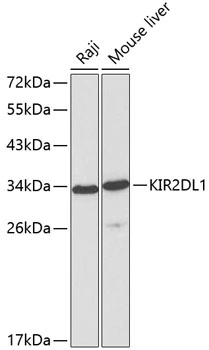
WB analysis of various sample lysates using GTX00788 KIR2DL1 antibody. Dilution : 1:1000 Loading : 25microg per lane
KIR2DL1 antibody

GTX00788
ApplicationsWestern Blot
Product group Antibodies
ReactivityHuman, Mouse
TargetKIR2DL1
Overview
- SupplierGeneTex
- Product NameKIR2DL1 antibody
- Delivery Days Customer9
- ApplicationsWestern Blot
- CertificationResearch Use Only
- ClonalityPolyclonal
- ConjugateUnconjugated
- Gene ID3802
- Target nameKIR2DL1
- Target descriptionkiller cell immunoglobulin like receptor, two Ig domains and long cytoplasmic tail 1
- Target synonymsCD158 antigen-like family member A; CD158A; killer cell immunoglobulin-like receptor 2DL1; killer cell immunoglobulin-like receptor, two domains, long cytoplasmic tail, 1; killer inhibitory receptor 2-2-1; KIR221; KIR2DL protein; KIR2DL1/3DL2; KIR2DL3; KIR-K64; MHC class I NK cell receptor; natural killer-associated transcript 1; NKAT; NKAT1; NKAT-1; p58 killer cell inhibitory receptor KIR-K64; p58 natural killer cell receptor clones CL-42/47.11; p58 NK cell inhibitory receptor NKR-K6; p58 NK receptor CL-42/47.11; p58.1; p58.1 MHC class-I-specific NK receptor
- HostRabbit
- IsotypeIgG
- Scientific DescriptionKiller cell immunoglobulin-like receptors (KIRs) are transmembrane glycoproteins expressed by natural killer cells and subsets of T cells. The KIR genes are polymorphic and highly homologous and they are found in a cluster on chromosome 19q13.4 within the 1 Mb leukocyte receptor complex (LRC). The gene content of the KIR gene cluster varies among haplotypes, although several framework genes are found in all haplotypes (KIR3DL3, KIR3DP1, KIR3DL4, KIR3DL2). The KIR proteins are classified by the number of extracellular immunoglobulin domains (2D or 3D) and by whether they have a long (L) or short (S) cytoplasmic domain. KIR proteins with the long cytoplasmic domain transduce inhibitory signals upon ligand binding via an immune tyrosine-based inhibitory motif (ITIM), while KIR proteins with the short cytoplasmic domain lack the ITIM motif and instead associate with the TYRO protein tyrosine kinase binding protein to transduce activating signals. The ligands for several KIR proteins are subsets of HLA class I molecules; thus, KIR proteins are thought to play an important role in regulation of the immune response. [provided by RefSeq, Jul 2008]
- ReactivityHuman, Mouse
- Storage Instruction2°C to 8°C,-20°C or -80°C
- UNSPSC12352203
